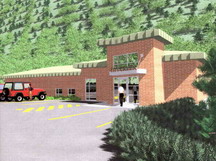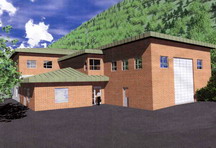City Creek Water Treatment Plant Reconstruction Project
Salt Lake City's First Water Treatment Plant To Be Refurbished Beginning This Fall
February 12, 2004
BACKGROUND
|
In the early years water flowed through ditches for irrigating gardens. Residents hand dipped water for their culinary and domestic needs. Twenty-nine years later, City Creek was diverted into a municipally-owned, piped water distribution system to provide fire protection and culinary water supply to city residents. In 1917, chlorine was added to City Creek water to eliminate water-borne pathogen bacteria from the public drinking water supply. In 1953, it would be the site for the State of Utah's first municipally owned water treatment plant.
City Creek Canyon collects water from 19.2 square miles of watershed that feeds the 14.5 mile-long City Creek stream. The City Creek Treatment Plant is located approximately 3 miles from the canyon entrance on Bonneville Boulevard. City Creek Canyon is a protected watershed above the water treatment facility and designated as the City Creek Nature Preserve.
RECONSTRUCTION SCOPE OF WORK
After 50 years of service, the treatment facility is scheduled for reconstruction to bring the office/chemical building structure up to current seismic standards and change out process control, electrical and mechanical equipment. The existing equipment has reached its useful life. Most of the equipment has either worn out or replacement parts are no longer available. Significant improvements to equipment technology have been made since the plant was first constructed that can improve efficiency and promote savings in operating costs. Furthermore, automation opportunities exist that were not available in the 1950s.
The current conventional treatment process was evaluated, and it was decided to keep the conventional process of coagulation, sedimentation, filtration and chlorination, rather than changing to membrane technology. The existing treatment process train is proven technology that has a record of producing high quality drinking water. Compared to membrane or hybrid alternatives, conventional treatment has the lowest construction life cycle and ongoing operation and maintenance costs.
The construction project is scheduled for fall 2004 with a completion date of spring 2006. The treatment plant will remain operational through most of the construction period. Improvements will address water quality and public health aspects of the plant.
The construction includes:
- Abatement of asbestos and lead based paint
- Demolition of the old office/chemical storage/chemical feed structure
- Reconstruct the office/chemical storage/chemical feed structure
- Modernization of monitoring instruments and computer control (SCADA) systems
- Upgrade treatment process equipment
In addition to the water treatment plant upgrades, other related facility improvements are necessary to ensure a reliable drinking water supply from City Creek. These improvements include modifications to the North Bench Pumping Station, demolition of the Pleasant Valley Reservoir and improvements to allow the elimination of the Brick Tank located downstream from the City Creek Water Treatment Plant. These projects will be contracted for separately as funding becomes available.
PUBLIC INFORMATION
Due to the high recreational use and public value associated with City Creek Canyon, the Department of Public Utilities will initiate public information meetings to solicit input and mitigate user concerns during the construction project. The Avenues and Capitol Hill Community Councils will be provided periodic updates on construction activities to keep the public informed during the course of the project. If you have any initial questions or concerns regarding the project, please contact Bob Sperling at 801-483-6888 (bob.sperling@slcgov.com).
RECREATION ACTIVITIES WITHIN CITY CREEK CANYON
Recreational use in the City Creek Nature Preserve is important to the community. The canyon will be kept open for public use under current policy (bikes on odd days, vehicle access to picnic sites on even days) whenever possible during construction. As always, the public should exercise extreme caution on the roadway, observe the 15 mph speed limit, and be aware of the potential for oncoming maintenance or construction vehicle traffic at all times. There will be some time periods during the project when recreational users will be required to wait at the bottom or top of the canyon while large construction vehicles are driving up or down the canyon. The contractor will be required to manage traffic, but a project of this magnitude will result in more vehicles in the canyon. Restrictions are for the public safety, and the public is asked to be patient.
Questions about using City Creek Canyon can be addressed to Florence Reynolds at 801-483-6864 (florence.reynolds@slcgov.com).

